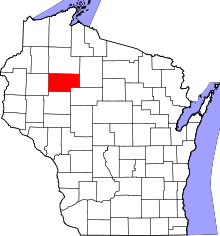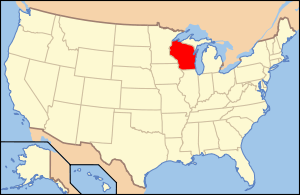Rusk County, Wisconsin
| Rusk County, Wisconsin | |
|---|---|
 Location in the U.S. state of Wisconsin | |
 Wisconsin's location in the U.S. | |
| Founded | 1901 |
| Named for | Jeremiah McLain Rusk |
| Seat | Ladysmith |
| Largest city | Ladysmith |
| Area | |
| • Total | 931 sq mi (2,411 km2) |
| • Land | 914 sq mi (2,367 km2) |
| • Water | 17 sq mi (44 km2), 1.9% |
| Population | |
| • (2010) | 14,755 |
| • Density | 16/sq mi (6/km²) |
| Congressional district | 7th |
| Time zone | Central: UTC-6/-5 |
| Website |
www |
Rusk County is a county in the U.S. state of Wisconsin. As of the 2010 census, the population was 14,755.[1] Its county seat is Ladysmith.[2]
History
Founded in 1901, Rusk County was originally named Gates County after Milwaukee land speculator James L. Gates.[3] It was renamed Rusk County in 1905 after Jeremiah M. Rusk, governor of Wisconsin and the first U.S. Secretary of Agriculture.[4] It was formed out of the northern portion of Chippewa County.[5]
Geography
According to the U.S. Census Bureau, the county has a total area of 931 square miles (2,410 km2), of which 914 square miles (2,370 km2) is land and 17 square miles (44 km2) (1.9%) is water.[6]
Adjacent counties
- Sawyer County - north
- Price County - east
- Taylor County - southeast
- Chippewa County - south
- Barron County - west
- Washburn County - northwest
Major highways
Airport
- KRCX - Rusk County Airport serves the county and surrounding communities.
Demographics

| Historical population | |||
|---|---|---|---|
| Census | Pop. | %± | |
| 1910 | 11,160 | — | |
| 1920 | 16,403 | 47.0% | |
| 1930 | 16,081 | −2.0% | |
| 1940 | 17,737 | 10.3% | |
| 1950 | 16,790 | −5.3% | |
| 1960 | 14,794 | −11.9% | |
| 1970 | 14,238 | −3.8% | |
| 1980 | 15,589 | 9.5% | |
| 1990 | 15,079 | −3.3% | |
| 2000 | 15,347 | 1.8% | |
| 2010 | 14,755 | −3.9% | |
| Est. 2015 | 14,124 | [7] | −4.3% |
| U.S. Decennial Census[8] 1790–1960[9] 1900–1990[10] 1990–2000[11] 2010–2014[1] | |||
As of the census[12] of 2000, there were 15,347 people, 6,095 households, and 4,156 families residing in the county. The population density was 17 people per square mile (6/km²). There were 7,609 housing units at an average density of 8 per square mile (3/km²). The racial makeup of the county was 97.69% White, 0.51% Black or African American, 0.42% Native American, 0.26% Asian, 0.10% Pacific Islander, 0.35% from other races, and 0.66% from two or more races. 0.76% of the population were Hispanic or Latino of any race. 32.7% were of German, 13.6% Polish, 9.0% Norwegian, 6.8% Irish, 6.2% American and 5.6% English ancestry according to Census 2000.
There were 6,095 households out of which 28.60% had children under the age of 18 living with them, 55.90% were married couples living together, 7.90% had a female householder with no husband present, and 31.80% were non-families. 27.00% of all households were made up of individuals and 14.30% had someone living alone who was 65 years of age or older. The average household size was 2.45 and the average family size was 2.97.
In the county, the population was spread out with 24.80% under the age of 18, 7.90% from 18 to 24, 24.80% from 25 to 44, 24.10% from 45 to 64, and 18.50% who were 65 years of age or older. The median age was 40 years. For every 100 females there were 98.50 males. For every 100 females age 18 and over, there were 97.40 males.
Communities
City
- Ladysmith (county seat)
Villages
Towns
Unincorporated communities
Ghost towns
- Atlanta
- Big Bend
- Crane
- Egypt
- Flambeau
- Horseman (Varner)
- Jerome
- Kalish
- Mandowish (Manedowish)
- Poplar / Beldonville
- Pre Bram
- Shaws Farm
- Teresita
- Tibbets
- Vallee View / Walrath
- West Ingram
- Wilson Center / Dogville (Starez)
See also
References
- 1 2 "State & County QuickFacts". United States Census Bureau. Retrieved January 23, 2014.
- ↑ "Find a County". National Association of Counties. Retrieved 2011-06-07.
- ↑ Gannett, Henry (1905). The Origin of Certain Place Names in the United States. Govt. Print. Off. p. 135.
- ↑ "Here's How Iron Got Its Name". The Rhinelander Daily News. June 16, 1932. p. 2. Retrieved August 24, 2014 – via Newspapers.com.

- ↑ Rusk County Museum
- ↑ "2010 Census Gazetteer Files". United States Census Bureau. August 22, 2012. Retrieved August 8, 2015.
- ↑ "County Totals Dataset: Population, Population Change and Estimated Components of Population Change: April 1, 2010 to July 1, 2015". Retrieved July 2, 2016.
- ↑ "U.S. Decennial Census". United States Census Bureau. Retrieved August 8, 2015.
- ↑ "Historical Census Browser". University of Virginia Library. Retrieved August 8, 2015.
- ↑ Forstall, Richard L., ed. (March 27, 1995). "Population of Counties by Decennial Census: 1900 to 1990". United States Census Bureau. Retrieved August 8, 2015.
- ↑ "Census 2000 PHC-T-4. Ranking Tables for Counties: 1990 and 2000" (PDF). United States Census Bureau. April 2, 2001. Retrieved August 8, 2015.
- ↑ "American FactFinder". United States Census Bureau. Retrieved 2011-05-14.
External links
 |
Washburn County | Sawyer County |  | |
| Barron County | |
Price County | ||
| ||||
| | ||||
| Chippewa County | Taylor County |
Coordinates: 45°29′N 91°08′W / 45.48°N 91.14°W